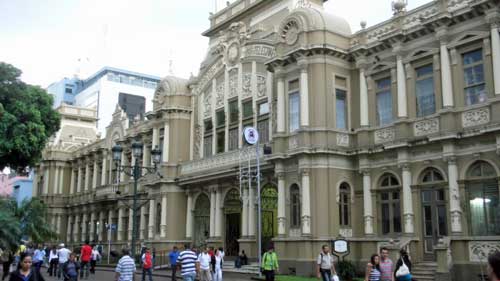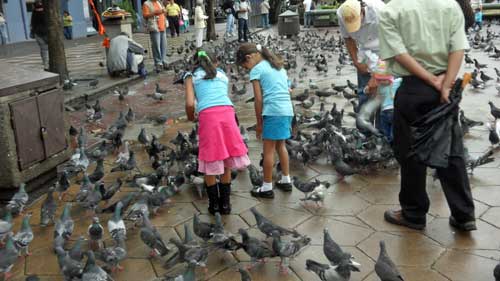
By Judy Pinegar
Well, really day two, but getting in last night an hour before midnight doesn’t count!! The trip didn’t start too well as they held us for an hour in Sacramento while they fixed some computer problem. This caused us to miss our connection in Denver to go to Houston. When we got there we were told we had been rescheduled on Continental, but arriving at that gate we found it was NOT reserved. We were then put on “standby” but luckily got on anyway. Then somebody had a medical emergency (heart) on our plane, but (also luckily) there were 3 Doctors on board.
The Hotel Aranjuez in San Jose is very nice and inexpensive too. Wonderful FULL breakfast included with a double room (actually two beds and a bath) for US$ 48.00. It is within walking distance of the main downtown, which is what we did today. …oh and RAIN…did I mention it was raining… (pouring) most of the morning? John and I were prepared, but several hours into it Ted realized his windbreaker was not waterproof (duh)…but tiendas (shops) abound so we found a nice waterproof Adidas jacket with hood.
Our walking tour started with the Rafael Angel Calderón Museum, Costa Rica’s (CR) President from 1940-44, and the social reforms he helped to create in that time period. Educated in Costa Rica and Belgium as a medical doctor, Calderón soon turned his back on the conservative coffee elite to address widespread poverty and poor health conditions among the working poor. He became the first Central American president to primarily focus his attention on poverty and deteriorating social conditions.
During his presidency he established the Work Code, which introduced the minimum wage and other important protections for laborers. Prior to this reform, working conditions for Costa Rica’s poor had been abhorrent. Calderón also founded a national social security retirement program, extremely advanced for its time. He also instituted a national healthcare program. In education, he established the University of Costa Rica. To this day, Costa Rica has been well-known around the world for its system of universal health care, its high education levels, and the social security system founded under Calderón.
We walked past the red roofed Santa Teresita Church, visited the National Center of Arts and Technology, Casa del Cuno Gallery (former House of Currency), The National Park, and the “Metal Building”. The Metal Building is a symbol of the public education system in Costa Rica, and it is constructed of pieces of iron that were brought by sea in pieces from Belgium. It has housed two public schools since 2000. The literacy rate in Costa Rica is 96% (CIA World Fact Book, February 2007), one of the highest in Latin America, and elementary as well as high schools are found throughout the country in virtually every community.
Continuing our walk, through Morazan Park, we visited the Museo de Oro (Gold Museum) here, thousands of pre-Columbian hand made gold artifacts totaling over 20,000 troy ounces are in the viewing rooms. This collection started in the 1950’s when the Central Bank of Costa Rica started collecting artifacts and other antiquities. In Costa Rica, archaeological evidence indicates that the first metal objects appeared around 400-500 AD. The manufacture of metal objects reached its maximum development after the year 700 AD and lasted until contact with the Spanish. The majority of the metal objects that have been recovered in Costa Rica come from the southern Pacific area,due to the existence of natural gold and copper deposits in this region.
By hammering small fragments of gold, they made laminated pieces in the form of chest plates, bracelets, hair bands and discs, which were decorated with geometric designs, animal forms and representations of humans. Smelting with the lost-wax technique was the most used in the production of gold objects. The technique consisted of first modeling the desired object in beeswax. The design was covered with several layers of clay, forming in this way a sort of mould that was left to dry for a few days. This mould was heated so that the wax melted and drained off through a conduit that had been left for this purpose. Melting the wax in the inside of the mould left a hollow space in the form of the original design which was filled with the smelted metal. After the mould cooled, the mould was broken and the object cleaned, and the conduits where the metal had been poured in cut off, touched up and polished.
In the gold work are representations of fauna such as fish, crabs, turtles, armadillos, deer, jaguars, small lizards, lizards and frogs. These representations provide evidence of the importance of the natural surroundings in relation to the human being.
We completed our tour of San Juan, and arrived back at our hotel before the evening rain set in!
Judy Pinegar is a writer and her articles have appeared in numerous publications
.
View Larger Map
.
For all your real estate needs
Call or email
John J. O’Dell® GRI
Real Estate Broker
O’Dell Realty
(530) 263-1091
jodell@nevadacounty.com
